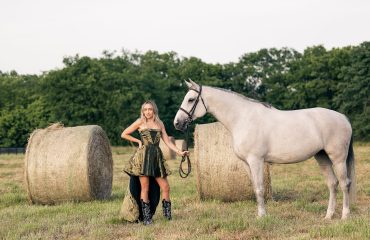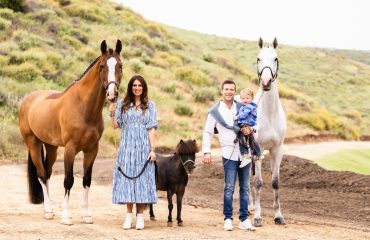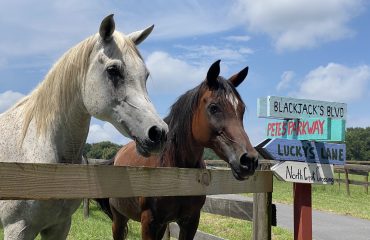Derek di Grazia and his wife Bea (neé Perkins) di Grazia have been around eventing for a long time. They met when they worked for Jimmy Wofford and their combined training experience spans nearly 70 years. Now based at their Stillwater Farm in Carmel, CA, the di Grazias train, conduct clinics and also bring along young horses to sell. They wear many hats. Both Derek and Bea continue to show their young stock, but one facet in particular of their equestrian three-day enterprises has really taken hold. Derek is an FEI International level course designer and a USEF National course advisor. He was Assistant Course Designer for both Rolex and the Alltech FEI World Equestrian Games. His handiwork for more than 15 years is well known by two- and three-star riders at Fair Hill International CCI***, Bromont CCI***, Stuart Horse Trials and Twin Rivers Horse Trials, to name just a few. Two years ago, Janie Atkinson, the energy behind the Rolex Kentucky Three-Day Event, asked Derek to help Mike Etherington-Smith, slated to retire in 2010 after Rolex and the World Games. From there it was just a hop, skip and a jump to taking over the cross-country course design for the Rolex CCI****.
Sidelines: When did you realize that course design suited you?
DdG: I don’t know if there was a flash, but at the 1986 World Championships, [AUS] I was officially helping out at events, both in California where I grew up, and also where I was living on the East Coast. Bea’s family owned Huntington Farm (VT), which held horse trials in the summer so we always would be helping out with the courses. I was sort of involved all along. At one point, Stephen Hales, manager at Wild Horse Valley Ranch, asked me to come out and design the preliminary course for their horse trials and it just went on from there.
Sidelines: How do you view the change from classic long format to short? Did you leap through any learning curves to accommodate new XC design?
DdG: I was part of the long format for quite a while and you get used to doing something from a rider’s perspective. Organizers definitely save money and time, as they are not flagging Roads & Tracks or putting together a Steeplechase phase.
As for the course, there was a bit of a learning curve for the first couple of years seeing how the horses were going to respond to doing a longer course without having the other phases first. Riders also found that their horses needed to be just as fit although maybe in a slightly different way. Now I think we’re in a better place because the riders are preparing their horses correctly and understanding more about riding the longer courses in this format.
Course designers have changed in that the intensity level on courses has lessened as opposed to a few years ago where we had many efforts in a short amount of distance. Design has evolved and will continue to as we continue to make changes for a safer sport. It’s better.
Sidelines: How do two eventers with strong competitive streaks manage to keep the peace in the long pull?
DdG: It’s just been one of those relationships – we’ve been the best of friends over the years. We work together every day. We’ve been together for so long that we know what each is thinking about. We help each other and cover for each other in our coaching. It just works.
Sidelines: What advice do you have for students who aspire to the upper levels?
DdG: It’s interesting with students. Some come by it naturally; others have to learn by much repetition. The more times you go around a course, the more you learn, but in this day and age, you’re lucky if you have more than one horse. If you have five or six horses, by your second or third time around the cross-country, you get so you don’t have to think about it as you have already reacted. Ride as many horses as you can.
Sidelines: What about your first solo design for the Rolex cross-country? Are you artistic by nature in terms of the design?
DdG: The first thing is to have a track that flows well. Then I work on jump placement and the shape of the jumps. I like working with terrain to see how it is going to work best for me within the course. I enjoy working with space and knowing how things should fit into it. I don’t think about making the course into a theme park. It’s more about getting the jumps right.
By Lauren Giannini













